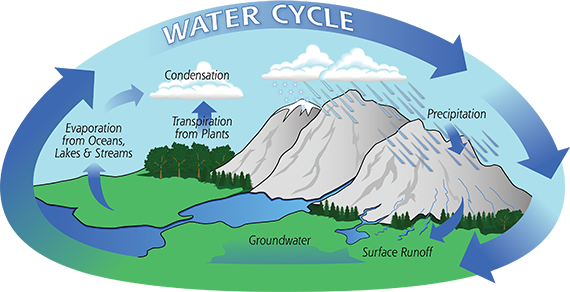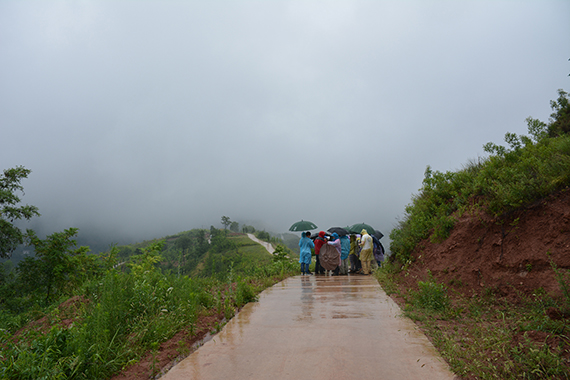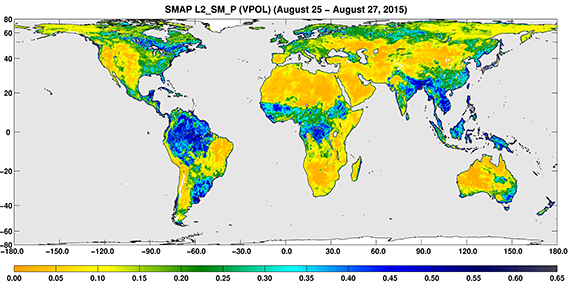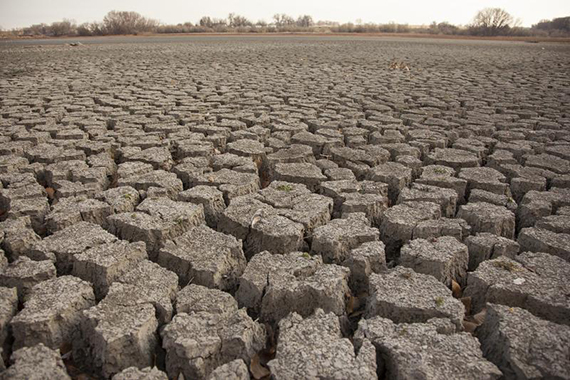What is the MAIN reason water from the oceans turns to water vapor, and then evaporates into the air
All of the water on Earth makes up the hydrosphere. And that water doesn't stay still. It is always on the motility. Rain falling today may take been water in a afar ocean days before. And the water y'all see in a river or stream may have been snow on a high mountaintop. Water is in the temper, on the land, in the ocean, and underground. It moves from place to identify through the water cycle .
Where's the water?
There are about i.4 billion km3 of water (336 million mi3 of water) on World. That includes liquid water in the ocean, lakes, and rivers. Information technology includes frozen water in snow, ice, and glaciers, and water that'southward underground in soils and rocks. It includes the water that's in the atmosphere equally clouds and vapor.
If you could put all that water together – similar a gigantic water drop – it would be 1,500 kilometers (930 miles) beyond.
Of all the h2o in the hydrosphere, the vast majority, nigh 97% of it, fills the sea. About 2% of the water on Earth is frozen in ice sheets nigh the poles and in glaciers. Sometimes the ice on Globe is included in the hydrosphere and sometimes it's seperated into a special office of the Earth system chosen the cryosphere. About of the ice is in Antarctica, a smaller amount in Greenland in the Arctic, and a tiny fraction in mountain glaciers around the globe. Most of the remaining one% of Earth's water is underground, in shallow aquifers, equally soil moisture, or deep underground in stone layers. Only a small fraction of the water on Earth (0.03%) is in lakes, wetlands, and rivers.

The master processes in the water cycle
Credit: NASA
Water's on the motion.
As it moves through the water bicycle, h2o often changes from a liquid, to a solid (ice), to a gas (water vapor). Water in oceans and lakes is typically liquid; but it is solid ice in glaciers, and ofttimes invisible water vapor in the atmosphere. Clouds are tiny aerosol of liquid water or minor ice crystals.
H2o at the surface of the ocean, rivers, and lakes can become h2o vapor and move into the temper with a picayune added energy from the Sun through a procedure chosen evaporation. Snow and water ice can likewise turn into water vapor, which is a process known as sublimation. And water vapor gets into the atmosphere from plants, too, which is chosen transpiration.
Because air is cooler at higher altitude in the troposphere, h2o vapor cools as it rises high in the atmosphere and transforms into h2o droplets past a process called condensation. The water droplets that form make upwardly clouds. Water vapor can likewise condense into droplets near the ground, forming fog when the ground is cold. If the temperature is common cold plenty, ice crystals form instead of liquid water aerosol.
If the droplets or water ice crystals within clouds abound in size, they somewhen become besides heavy to stay in the air, falling to the footing as pelting, snow, and other types of atmospheric precipitation.
What happens to the rain and snow that fall?
Around the earth, each year, almost 505,000 kmthree (121,000 mi3) of h2o falls as pelting, snowfall, and other types of precipitation.
86% of those raindrops and snowflakes come up from the ocean where 434,000 km3(104,000 mi3) of water evaporates into the atmosphere each year. Water eventually returns to the ocean as precipitation that falls directly into the sea and every bit precipitation that falls on land and flows to the bounding main through rivers.
Less water evaporates over the land than falls onto land as precipitation. Evaporation of water from the land happens direct from lakes, puddles, and other surface water. Also, water also makes its way into the atmosphere via a process called transpiration in which plants release water into the air from their leaves that was pulled upward from the soil through roots. Collectively, the water evaporated from the country and from plants is called evapotranspiration.
Some of the snow and water ice that falls equally precipitation stays on the land as a part of icy mountaintop glaciers or the ice sheets that cover places similar Greenland and Antarctica. Some of the precipitation seeps into the ground and joins the groundwater that is often tapped by wells to provide water to farms, towns, and cities.

A rainy day in the countryside near Xi'an, China
Credit: L.S. Gardiner
How long does water stay in a identify earlier it moves?
The length of time that detail water molecules stay in a office of the water bike is quite variable, but water does stay in certain places longer than others.
A drib of water may spend over 3,000 years in the ocean before evaporating into the air, while a drib of h2o spends an boilerplate of just nine days in the atmosphere before falling dorsum to World.
Water spends thousands to hundreds of thousands of years in the large ice sheets that comprehend Antarctica and Greenland. The oldest ice in Antarctica has been there for 2.7 million years. However, snow that falls in the wintertime may merely stick around for a few days in mid-latitudes locations, where temperatures oft rise above freezing causing the snow to melt, or up to 6 months closer to the Arctic, where temperatures stay below freezing all wintertime.
Water stays in soil for around 1 to ii months although this varies greatly. Water that'due south in soil moves into the atmosphere by evaporation and also by transpiration.
At that place are exceptions. For example, while h2o vapor spends relatively fiddling time in the atmosphere, vapor that makes its way into the stratosphere, the layer of the atmosphere above the troposphere where weather typically forms, may remain there for a long time. Also, while water generally spends thousands of years in the ocean earlier moving on, water in warm, shallow coastal areas may evaporate and go out the ocean very quickly as compared with other areas of the body of water.

Soil moisture is typically college at tropical latitudes than elsewhere. This three-day blended global map of surface soil moisture was made with data from the NASA SMAP radiometer musical instrument between Aug. 25-27, 2015. Moist soils are shown in blue. The most dry soils are shown in yellowish and orange.
Credit: NASA
Climate change is affecting the h2o cycle.
Warming global temperatures increases the charge per unit of evaporation and precipitation. The impacts are expected to increase over this century as climate warms. Some areas may experience heavier than normal precipitation, and other areas may become decumbent to droughts. Other parts of the h2o cycle - such equally clouds, the ocean, glaciers and sea ice - are also affected by climate modify.
- Larn more than: The Water Cycle and Climate Change

Mudcracks form during droughts when the basis dries out and moisture evaporates. As climate continues to modify, some areas are becoming more drought prone.
Credit: NOAA
Source: https://scied.ucar.edu/learning-zone/how-weather-works/water-cycle
0 Response to "What is the MAIN reason water from the oceans turns to water vapor, and then evaporates into the air"
Postar um comentário